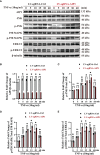ASK1-Interacting Protein 1 Acts as a Novel Predictor of Type 2 Diabetes
- PMID: 35712257
- PMCID: PMC9196954
- DOI: 10.3389/fendo.2022.896753
ASK1-Interacting Protein 1 Acts as a Novel Predictor of Type 2 Diabetes
Erratum in
-
Corrigendum: ASK1-interacting protein 1 acts as a novel predictor of type 2 diabetes.Front Endocrinol (Lausanne). 2022 Aug 16;13:981231. doi: 10.3389/fendo.2022.981231. eCollection 2022. Front Endocrinol (Lausanne). 2022. PMID: 36051384 Free PMC article.
Abstract
Type 2 diabetes (T2D) mellitus is a chronic inflammatory disease characterized with high secretion of tumor necrosis factor (TNF)-α, but the regulatory pathway of TNF-α production in T2D has not been fully elucidated. ASK1-interacting protein 1 (AIP1) is a signaling scaffold protein that modulates several pathways associated with inflammation. In this study, we aimed to investigate the role of AIP1 in T2D development. Our results revealed that AIP1 was downregulated in omental adipose tissue (OAT) of obese patients with T2D compared with that in obese patients. In addition, Pearson's correlation test showed that AIP1 was negatively correlated with the homeostatic model assessment for insulin resistance (HOMA-IR, r = -0.4829) and waist-to-hip ratio (r = -0.2614), which are major clinical indexes of T2D. As revealed by the proteomic analysis, immunohistochemistry, and ELISA, the OAT and the serum of obese patients with T2D presented high inflammatory status. And the increased inflammatory factors TNF-α and C-reactive protein C (CRP) in the serum of obese patients with T2D showed a positive correlation with HOMA-IR (TNF-α, r = 0.4728; CRP, r = 0.5522). Interestingly, AIP1 deficiency in adipocytes facilitated TNF-α secretion and retarded glucose uptake. Mechanistically, AIP1 deletion in human adipocytes activated JNK, p38 MAPK, and ERK1/2 signaling. Furthermore, inhibition of these signaling pathways using specific inhibitors could suppress these signal activation and insulin resistance caused by AIP1 deficiency. In addition, AIP1 and TNF-α expression in the OAT of patients with T2D recovered to normal levels after laparoscopic Roux-en-Y gastric bypass (RYGB) surgery. These findings indicate that AIP1 is negatively correlated with the clinical indexes of T2D. It modulates TNF-α expression in OAT via JNK, p38 MAPK, and ERK1/2 signaling.
Keywords: AIP1; adipose inflammation; insulin resistance; type 2 diabetes; visceral adipose.
Copyright © 2022 Song, Chen, He, Liu, Ji, Wu and He.
Conflict of interest statement
The authors declare that the research was conducted in the absence of any commercial or financial relationships that could be construed as a potential conflict of interest.
Figures







Similar articles
-
RIP1-mediated AIP1 phosphorylation at a 14-3-3-binding site is critical for tumor necrosis factor-induced ASK1-JNK/p38 activation.J Biol Chem. 2007 May 18;282(20):14788-96. doi: 10.1074/jbc.M701148200. Epub 2007 Mar 27. J Biol Chem. 2007. PMID: 17389591
-
AIP1 mediates TNF-alpha-induced ASK1 activation by facilitating dissociation of ASK1 from its inhibitor 14-3-3.J Clin Invest. 2003 Jun;111(12):1933-43. doi: 10.1172/JCI17790. J Clin Invest. 2003. PMID: 12813029 Free PMC article.
-
Tumor necrosis factor alpha-induced desumoylation and cytoplasmic translocation of homeodomain-interacting protein kinase 1 are critical for apoptosis signal-regulating kinase 1-JNK/p38 activation.J Biol Chem. 2005 Apr 15;280(15):15061-70. doi: 10.1074/jbc.M414262200. Epub 2005 Feb 8. J Biol Chem. 2005. PMID: 15701637
-
AIP1: a new player in TNF signaling.J Clin Invest. 2003 Jun;111(12):1813-5. doi: 10.1172/JCI18911. J Clin Invest. 2003. PMID: 12813014 Free PMC article. Review.
-
Recent advances in the relationship between obesity, inflammation, and insulin resistance.Eur Cytokine Netw. 2006 Mar;17(1):4-12. Eur Cytokine Netw. 2006. PMID: 16613757 Review.
Cited by
-
Therapeutic Potential of Myricitrin in a db/db Mouse Model of Type 2 Diabetes.Molecules. 2025 Mar 25;30(7):1460. doi: 10.3390/molecules30071460. Molecules. 2025. PMID: 40286055 Free PMC article.
-
DAB2IP inhibits glucose uptake by modulating HIF-1α ubiquitination under hypoxia in breast cancer.Oncogenesis. 2024 Jun 11;13(1):20. doi: 10.1038/s41389-024-00523-4. Oncogenesis. 2024. PMID: 38862467 Free PMC article.
-
An update on the tumor-suppressive functions of the RasGAP protein DAB2IP with focus on therapeutic implications.Cell Death Differ. 2024 Jul;31(7):844-854. doi: 10.1038/s41418-024-01332-3. Epub 2024 Jun 20. Cell Death Differ. 2024. PMID: 38902547 Free PMC article. Review.
References
-
- Cassano PA, Rosner B, Vokonas PS, Weiss ST. Obesity and Body Fat Distribution in Relation to the Incidence of Non-Insulin-Dependent Diabetes Mellitus. A Prospective Cohort Study of Men in the Normative Aging Study. Am J Epidemiol (1992) 136:1474–86. doi: 10.1093/oxfordjournals.aje.a116468 - DOI - PubMed
Publication types
MeSH terms
Substances
LinkOut - more resources
Full Text Sources
Medical
Research Materials
Miscellaneous

